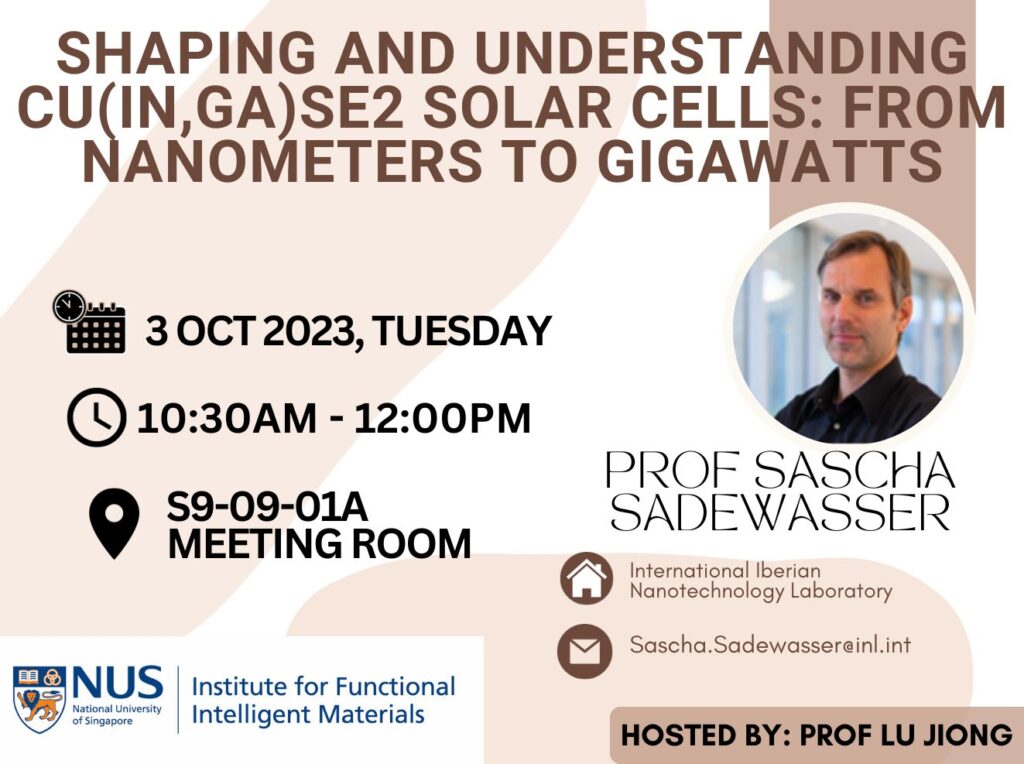ABSTRACT
The transition to a clean energy system is required to combat climate change. The direct conversion of solar energy into electricity through photovoltaics (PV) is an essential pillar in a clean energy system. While the market is dominated by crystalline silicon PV, thin-film PV provides advantages for specific applications, e.g. in building-integrated PV (BIPV). The Cu(In,Ga)Se2 (CIGSe) thin-film PV technology has demonstrate competitive power conversion efficiencies above 23%.
Specifically interesting for BIPV are semi-transparent PV (STPV) as windows. We are developing micro-patterned STPV that ensure color-neutral light transmission. Proof-of-concept CIGSe solar cells were fabricated by chemically etching a full solar cell, leading to spatially-segmented micro-sized line-shaped solar cells, invisible to the human eye at practical distances. Semi-transparent CIGSe solar cells with a total area efficiency of 7.6 % and an average visual transmittance (AVT) of 45 % [1] were achieved. To ensure large-scale material-efficient fabrication, we also develop selective-area deposition processes, and first devices reach nearly 4% active-area efficiency.
On the other hand, to improve the understanding of the limitations of polycrystalline CIGSe solar cells, we apply atomic force microscopy (AFM) methods to study their nanoscale electronic properties. Using Kelvin probe force microscopy (KPFM), we have shown that the electronic properties of grain boundaries (GBs) are beneficially modified by an alkali-fluoride post-deposition treatment (AlkF-PDT). Different potential variations at GBs are found for different alkali elements (K, Rb, and Cs), interpreted as hole and electron barriers. These barriers impact the open-circuit voltage of reference solar cell devices. Our findings suggest an effective passivation effect promoted by the AlkF-PDT [2]. To understand the impact below the near-surface region, we additionally applied a novel conductive AFM tomography method [3].
[1] P. Santos, …, S. Sadewasser, Thin Solid Films 770, 139778 (2023).
[2] N. Nicoara, …, S. Sadewasser, Nature Commun. 10, 3980 (2019).
[3] D. Sharma, …, S. Sadewasser, submitted (2023).
BIO
Dr. Sascha Sadewasser is the Principal Investigator of the Laboratory for Nanostructured Solar Cells at INL – International Iberian Nanotechnology Laboratory. The group of Sascha works on the development of advanced solar cell materials and devices implementing nano- and microstructures. Additionally, scanning probe microscopy methods, especially Kelvin probe force microscopy, are developed and applied for the characterization of the optoelectronic nanostructure of solar cell materials. The group also works on 2D chalcogenide materials and other energy-related materials.
Sascha Sadewasser holds a Diploma (1995) in Physics from the RWTH Aachen, Germany and a PhD (1999) from the Washington University St. Louis, MO, USA. After 2 post-docs in Berlin (Hahn-Institute) and Barcelona (Centro Nacional de Microelectrónica), he became group leader and later deputy department head at the Helmholtz-Zentrum Berlin, Germany. After his Habilitation in Experimental Physics from the Free University of Berlin, Germany (2011) he joined INL in 2011. Sascha has published more than 130 peer-reviewed papers (incl. Nature Communications, Physical Review Letters, and Advanced Energy Materials), with about 3600+ citations (h-index 35, web of science). He has published 5 book chapters and 2 books and has been granted 3 patents. He has participated in and coordinated several European and international collaboration projects and is a member of several scientific committees and evaluation boards.
(https://inl.int/nanostructured-solar-cells/)

